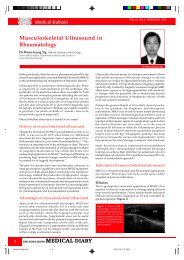MEDICAL DIARY - The Federation of Medical Societies of Hong Kong
MEDICAL DIARY - The Federation of Medical Societies of Hong Kong
MEDICAL DIARY - The Federation of Medical Societies of Hong Kong
Create successful ePaper yourself
Turn your PDF publications into a flip-book with our unique Google optimized e-Paper software.
20<br />
<strong>Medical</strong> Bulletin<br />
myocardium at baseline indicated increased risk <strong>of</strong> end<br />
points. At follow-up scintigraphy, the reduction in<br />
ischaemic myocardium was greater with PCI than with<br />
OMT particularly in patients with moderate to severe<br />
ischaemia at baseline. Patients with ischaemia reduction<br />
had lower risk for death or myocardial infarction. Death<br />
or MI rates ranged from 0% for patients with no<br />
residual ischaemia to 39% in patients with 10% residual<br />
ischaemia on follow-up stress test. This supported the<br />
importance <strong>of</strong> recognition and treatment <strong>of</strong> ischaemic<br />
burden rather than just anatomy as the goal <strong>of</strong><br />
interventional therapies.<br />
<strong>The</strong> COURAGE study indeed reconfirmed what we are<br />
currently practising. For those patients with minimal<br />
symptom or no symptom, optimal medical therapy<br />
<strong>of</strong>fers good control <strong>of</strong> symptom without increased risk<br />
<strong>of</strong> death or myocardial infarction. However, if there is<br />
significant inducible ischaemia on function test (e.g.<br />
stress scintigraphy), PCI could relief residual ischaemia<br />
and reduce cardiovascular events whether the patient is<br />
symptomatic or not. If medical therapy does not<br />
provide adequate angina relief, provide desired<br />
physical activity level to meet the patient's expectations,<br />
or the patient is intolerant <strong>of</strong> medical therapy, PCI is the<br />
treatment <strong>of</strong> choice. Last but not the least, OMT<br />
includes antiplatelet therapy (aspirin, clopidogrel), antiischaemic<br />
therapy (long-acting beta-blocker, long-acting<br />
calcium channel blocker, nitrate), lipid-lowering<br />
therapy (statin), extended-release niacin or fibrates (for<br />
low HDL) and exercise.<br />
Multivessel Disease<br />
<strong>The</strong> application <strong>of</strong> PCI in patients with multivessel<br />
disease remains controversial, particularly in the setting<br />
<strong>of</strong> diabetes mellitus. Multiple randomised trials have<br />
compared PCI with bare metal stents to coronary artery<br />
bypass graft surgery (CABG) in selected patients with<br />
multivessel coronary artery disease, and rates <strong>of</strong><br />
survival free from myocardial infarction have been<br />
similar. Typically, patients treated with PCI require<br />
more subsequent revascularisation procedures due to<br />
restenosis or incomplete revascularisation. <strong>The</strong> need to<br />
compare the use <strong>of</strong> DES and CABG in this setting is<br />
eagerly awaited.<br />
One-year follow-up data from the much anticipated<br />
Synergy Between PCI With Taxus and Cardiac Surgery<br />
(SYNTAX) trial was recently announced. 1800 patients<br />
were randomised to either CABG or PCI with the Taxus<br />
DES5. By 12-month, DES was statistically inferior to<br />
CABD for the primary composite end-points <strong>of</strong> allcause<br />
death, cerebrovasular event, MI and repeat<br />
revascularisation (12.1% vs 17.8%, p=0.0015). Indeed,<br />
there was no difference between all-cause death and MI<br />
between the two groups. However, PCI group had<br />
more repeat revascularisation (5.9% vs 13.7%, p

















